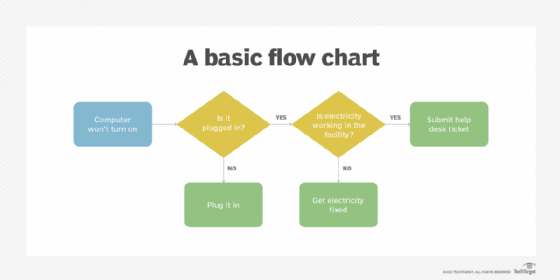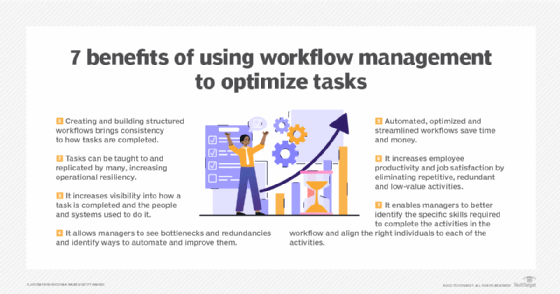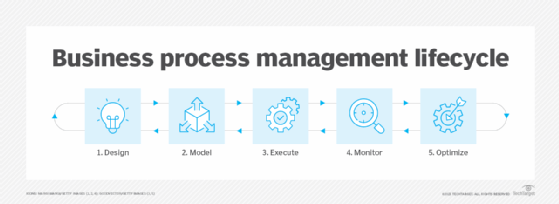workflow
What is a workflow?
Workflow is the series of activities that are necessary to complete a task. Each step in a workflow has a specific step before it and a specific step after it, except for the first and last steps.
In a linear workflow, an outside event usually initiates the first step. If the workflow has a loop structure, however, the completion of the last step will usually restart the first step.
Tools such as flow charts and process maps are used to visualize the steps involved in a workflow process and the order they should go in. Flow charts use simple geometric symbols and arrows to define if-then relationships. Process maps look similar, but they can also include support information. That information documents the resources that each step in a business process requires.
Workflow can be automated with software tools that use business rules to decide when one step has been successfully completed and the next step should begin. Some workflow management apps also coordinate dependent relationships between individual steps, a concept known as workflow orchestration. Workflow management software also provides templates for documentation and business process modeling, two important aspects of business process management (BPM).

Types of workflows
Workflows are categorized in various ways. At a basic level, they get grouped using one of these two approaches:
- Sequential. This type of workflow has a series of steps that happen one after the other to complete the task. A loan application approval typically follows a sequential workflow, where a step is finished before the next one starts. A rules-driven workflow is a subset of the sequential workflow category. It progresses along a sequential path based on which rules get triggered.
- Parallel. With this approach, a series of steps is tackled concurrently to move the task toward completion. An employee onboarding workflow often takes a parallel approach because many of the tasks required of a new hire -- from healthcare insurance enrollment to security clearances to direct deposit forms -- can happen simultaneously.
There are other ways to categorize workflows, including the following three:
- Process workflow. This approach comprises a predictable, repeatable sequence of tasks or steps.
- Case workflow. With these processes, the exact sequence of steps needed to complete the task is unknown at the start and can vary case by case.
- Project workflow. The flow of steps proceeds in a structured path similar to a process workflow, but there's some flexibility in when, how and even if all those steps must happen.
- Delivery workflow. The idea is to map out the series of steps needed to ensure physical items or information successfully reach the intended users.
- Request workflow. This type of workflow is also known as request fulfillment. It consists of a series of phases that must be completed to fulfill an important request within an enterprise.
- Task workflow. This is a more general term for a project management approach that compartmentalizes large projects into smaller tasks that are completed sequentially.
- State machine workflow. A state machine is an alternate approach to mapping out a business process. It presents a workflow as a set of states where specific events trigger the transitions from one state to another.
- Manual workflow. In a manual workflow, human action is required to complete each step or phase and move the whole process forward.
- Digital workflow. A digital workflow entails automating the activities needed to move the process forward with technologies like artificial intelligence (AI) and machine learning. Humans aren't explicitly involved in moving the process from one step to the next.
Examples and uses of workflows
Business workflows exist in every organization across all industries. Some follow similar, if not identical, steps from one organization to another. Others are unique to industries or the enterprise that's using them.
Workflows can be found in all departments and functions in an organization from product development and project management to back-office administration and front-end customer service. Some workflows are highly structured, while others are completely unstructured. Many fall between those two extremes.
Each workflow moves data from one step to the next. That's what distinguishes a workflow from a checklist, which is a collection of related and unrelated tasks.
A company can use a workflow to describe the process for paying an electric bill, for instance. It likely involves the following steps: receiving the bill, reviewing the bill, approving payment and disbursing the funds for payment.
A checklist can ensure team members adhere to a routine for powering down all electricity in a facility at the end of a business day. That's a process that doesn't necessarily involve specific steps where each one must happen in a certain order.
Typical examples of workflows include the following:
- Approval of employee paid time-off requests.
- Billing and invoicing.
- Customer onboarding.
- Intake of a customer request.
- Onboarding new employees.
- Performance assessment.
- Processing sales orders.
- Product assembly.
- Sales fulfillment.
- IT help desk ticket submission.
What are the benefits of workflows?
Workflows vary from business to business in terms of tools used for creating and maintaining them. However, the benefits they provide are similar and include the following:
- Increased visibility. Workflows show all important business operations and processes.
- Focused on necessary tasks. With more visibility into your business processes, leadership can determine which activities are necessary, saving time and resources, and eliminating redundancies.
- Reduced oversight. Too much unnecessary oversight or micromanagement can be burdensome for management and frustrate employees. Having an explicit workflow with clearly defined processes ensures everyone knows what tasks must be completed, by whom and when.
- Automation opportunities. Workflows can identify simple and repetitive actions -- such as sending messages and alerts to employees with instructions to complete tasks -- to automate. This streamlines processes and lets workers focus on more productive uses of their time.

What are the challenges of workflows?
Enterprises often experience challenges with the workflows they put in place to run their operations. The following are some commonplace ones:
- Complexities and delays. With a complex process, a workflow can be devised in a way that doesn't meet its needs and causes bottlenecks and delays. Also, if a workflow doesn't articulate the technology or other resources needed to finish a process, delays can occur.
- Lack of communication. If a workflow is insufficiently detailed, this lack of communication could bring the process to a halt as roles and responsibilities must be clarified, tasks reinterpreted and technical issues come up.
- Data management problems. A workflow must account for how data must be managed, otherwise human error can lead to bad data, or inadequate technology can cause data loss. In addition, data privacy and security can be compromised if data management isn't given priority.
- Automation issues. A business might pick the wrong software for needs when automating a workflow. Employees might be skeptical of such tools or reluctant to learn how to use them, especially if they're complex.
What are the components of a workflow?
There are three basic components within every workflow:
- Input is also called start or trigger. It's the information, materials and resources required to complete each step within a task.
- Transformation is also referred to as work. It's the actions taken to perform each step and move through the sequential or parallel steps.
- Output is also called result or outcome. It's the result of each step that then becomes the input for follow-on steps within the workflow. The finished task is the final output.
How to create a workflow
Workflows exist in organizations even if they're not well-defined or managed to any degree. However, workflows that aren't planned or managed often have operational inefficiencies.
On the other hand, thoughtfully created and well-managed workflows are efficient. They're also less prone to errors and likely to improve over time.
The creation of a workflow involves multiple steps that are depicted in a workflow diagram as a sequence of steps. They can also be written as a list of required actions.
Creating a process-improving workflow requires the following series of tasks:
- Identify the start and endpoint of the process.
- List or map out each step required to move from the start point to the endpoint.
- Assess whether these tasks must happen in a specific order and if so list or map them accordingly.
- Determine and document the resources and roles within the organization that are required to complete each step. Add required workflow rules or business process descriptions.
- Execute the workflow.
Most organizations use workflow management systems to set up, document and monitor workflows. These systems have libraries of pre-built workflows and provide building blocks that businesses can use to create new workflows. Some also have AI capabilities that identify and add efficiencies as well as improve business operations and processes.
What is workflow management?
Once an organization has created and documented a workflow, it must manage it as part of its overall BPM efforts. Workflow management is the discipline of creating, documenting, monitoring and improving a workflow. This process enables organizations to optimize workflows, ensuring each step is completed correctly, consistently and efficiently.
Workflow management also lets organizations identify and correct bottlenecks, superfluous steps and other problems within the workflow. These sorts of issues can slow the execution of tasks in a workflow, increase the risk of errors and require more resources than necessary to complete an activity.
When effectively implemented, workflow management can continuously improve an organization's workflows. Consequently, it saves time and money while reducing errors.
Demand for workflow management tools is strong: A 2023 market report on workflow management systems from Reportlinker.com put the global market for this technology at $6.65 billion in 2022 and predicted it would reach $46.47 billion by 2030.

What is workflow automation?
Workflow management also enables organizations to identify workflow steps or entire workflows that can be automated using defined business rules and other automation tools.
Workflow automation produces many benefits for the enterprise, including the following:
- Faster execution of workflows.
- Fewer errors when manual tasks are eliminated.
- Cost savings as a result of streamlined processes.
- Improved employee morale by eliminating redundancies and repetitive tasks.
- Improved customer experience and satisfaction because process automation speeds up customer service and resolution of customer requests.
Learn more about workflow and how it differs from BPM.






